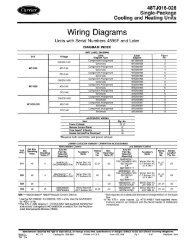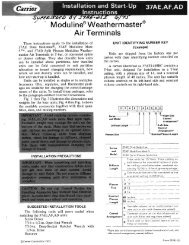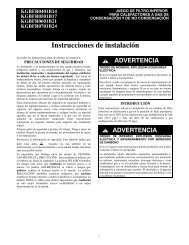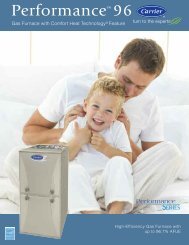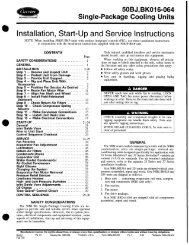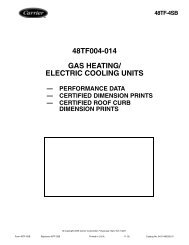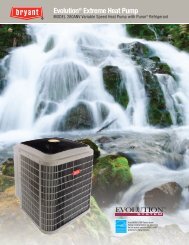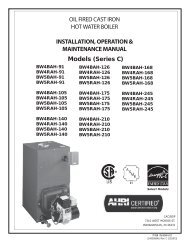Start-Up, Operation, and Maintenance Instructions
Start-Up, Operation, and Maintenance Instructions
Start-Up, Operation, and Maintenance Instructions
Create successful ePaper yourself
Turn your PDF publications into a flip-book with our unique Google optimized e-Paper software.
2. On low-voltage compressors (600 v or less) connect a<br />
voltmeter across the power wires to the compressor starter<br />
<strong>and</strong> measure the voltage. Compare this reading to the<br />
voltage rating on the compressor <strong>and</strong> starter nameplates.<br />
3. Compare the ampere rating on the starter nameplate to<br />
rating on the compressor nameplate. The overload trip<br />
amps must be 108% to 120% of the rated load amps.<br />
4. The starter for a centrifugal compressor motor must<br />
contain the components <strong>and</strong> terminals required for PIC II<br />
refrigeration control. Check the certified drawings.<br />
5. Check the voltage to the following components <strong>and</strong><br />
compare it to the nameplate values: oil pump contact,<br />
pumpout compressor starter, <strong>and</strong> power panel.<br />
6. Ensure that fused disconnects or circuit breakers have<br />
been supplied for the oil pump, power panel, <strong>and</strong><br />
pumpout unit.<br />
7. Ensure all electrical equipment <strong>and</strong> controls are properly<br />
grounded in accordance with job drawings, certified<br />
drawings, <strong>and</strong> all applicable electrical codes.<br />
8. Ensure the customer’s contractor has verified proper operation<br />
of the pumps, cooling tower fans, <strong>and</strong> associated<br />
auxiliary equipment. This includes ensuring motors are<br />
properly lubricated <strong>and</strong> have proper electrical supply <strong>and</strong><br />
proper rotation.<br />
9. For field-installed starters only, test the chiller compressor<br />
motor <strong>and</strong> its power lead insulation resistance with a<br />
500-v insulation tester such as a megohmmeter. (Use a<br />
5000-v tester for motors rated over 600 v.) Factorymounted<br />
starters do not require a megohm test.<br />
a. Open the starter main disconnect switch <strong>and</strong> follow<br />
lockout/tagout rules.<br />
If the motor starter is a solid-state starter, the motor leads<br />
must be disconnected from the starter before an insulation<br />
test is performed. The voltage generated from the tester can<br />
damage the starter solid-state components.<br />
b. With the tester connected to the motor leads, take<br />
10-second <strong>and</strong> 60-second megohm readings as<br />
follows:<br />
6-Lead Motor — Tie all 6 leads together <strong>and</strong> test<br />
between the lead group <strong>and</strong> ground. Next tie the<br />
leads in pairs: 1 <strong>and</strong> 4, 2 <strong>and</strong> 5, <strong>and</strong> 3 <strong>and</strong> 6. Test<br />
between each pair while grounding the third pair.<br />
3-Lead Motor — Tie terminals 1, 2, <strong>and</strong> 3 together<br />
<strong>and</strong> test between the group <strong>and</strong> ground.<br />
c. Divide the 60-second resistance reading by the<br />
10-second reading. The ratio, or polarization<br />
index, must be one or higher. Both the 10- <strong>and</strong><br />
60-second readings must be at least 50 megohms.<br />
If the readings on a field-installed starter are unsatisfactory,<br />
repeat the test at the motor with the<br />
power leads disconnected. Satisfactory readings in<br />
this second test indicate the fault is in the power<br />
leads.<br />
NOTE: Unit-mounted starters do not have to be<br />
megohm tested.<br />
10. Tighten all wiring connections to the plugs on the ISM<br />
<strong>and</strong> CCM modules.<br />
54<br />
11. On chillers with free-st<strong>and</strong>ing starters, inspect the power<br />
panel to ensure that the contractor has fed the wires into<br />
the bottom of the panel. Wiring into the top of the panel<br />
can cause debris to fall into the contactors. Clean <strong>and</strong> inspect<br />
the contactors if this has occurred.<br />
Carrier Comfort Network Interface — The Carrier<br />
Comfort Network (CCN) communication bus wiring is supplied<br />
<strong>and</strong> installed by the electrical contractor. It consists of<br />
shielded, 3-conductor cable with drain wire.<br />
The system elements are connected to the communication<br />
bus in a daisy chain arrangement. The positive pin of each system<br />
element communication connector must be wired to the<br />
positive pins of the system element on either side of it. The<br />
negative pins must be wired to the negative pins. The signal<br />
ground pins must be wired to the signal ground pins. See installation<br />
manual.<br />
NOTE: Conductors <strong>and</strong> drain wire must be 20 AWG<br />
(American Wire Gage) minimum str<strong>and</strong>ed, tinned copper.<br />
Individual conductors must be insulated with PVC, PVC/<br />
nylon, vinyl, Teflon, or polyethylene. An aluminum/polyester<br />
100% foil shield <strong>and</strong> an outer jacket of PVC, PVC/nylon,<br />
chrome vinyl, or Teflon with a minimum operating temperature<br />
range of –4 F to 140 F (–20 C to 60 C) is required. See<br />
table below for cables that meet the requirements.<br />
MANUFACTURER CABLE NO.<br />
Alpha 2413 or 5463<br />
American A22503<br />
Belden 8772<br />
Columbia 02525<br />
When connecting the CCN communication bus to a system<br />
element, a color code system for the entire network is recommended<br />
to simplify installation <strong>and</strong> checkout. The following<br />
color code is recommended:<br />
SIGNAL TYPE<br />
Check <strong>Start</strong>er<br />
CCN BUS<br />
CONDUCTOR<br />
INSULATION<br />
COLOR<br />
CCN TERMINAL<br />
CONNECTION<br />
+ Red RED (+)<br />
Ground White WHITE (G)<br />
– Black BLACK (–)<br />
BE AWARE that certain automatic start arrangements can<br />
engage the starter. Open the disconnect ahead of the starter<br />
in addition to shutting off the chiller or pump.<br />
Use the instruction <strong>and</strong> service manual supplied by the starter<br />
manufacturer to verify the starter has been installed correctly,<br />
to set up <strong>and</strong> calibrate the starter, <strong>and</strong> for complete troubleshooting<br />
information.<br />
The main disconnect on the starter front panel may not<br />
deenergize all internal circuits. Open all internal <strong>and</strong><br />
remote disconnects before servicing the starter.







